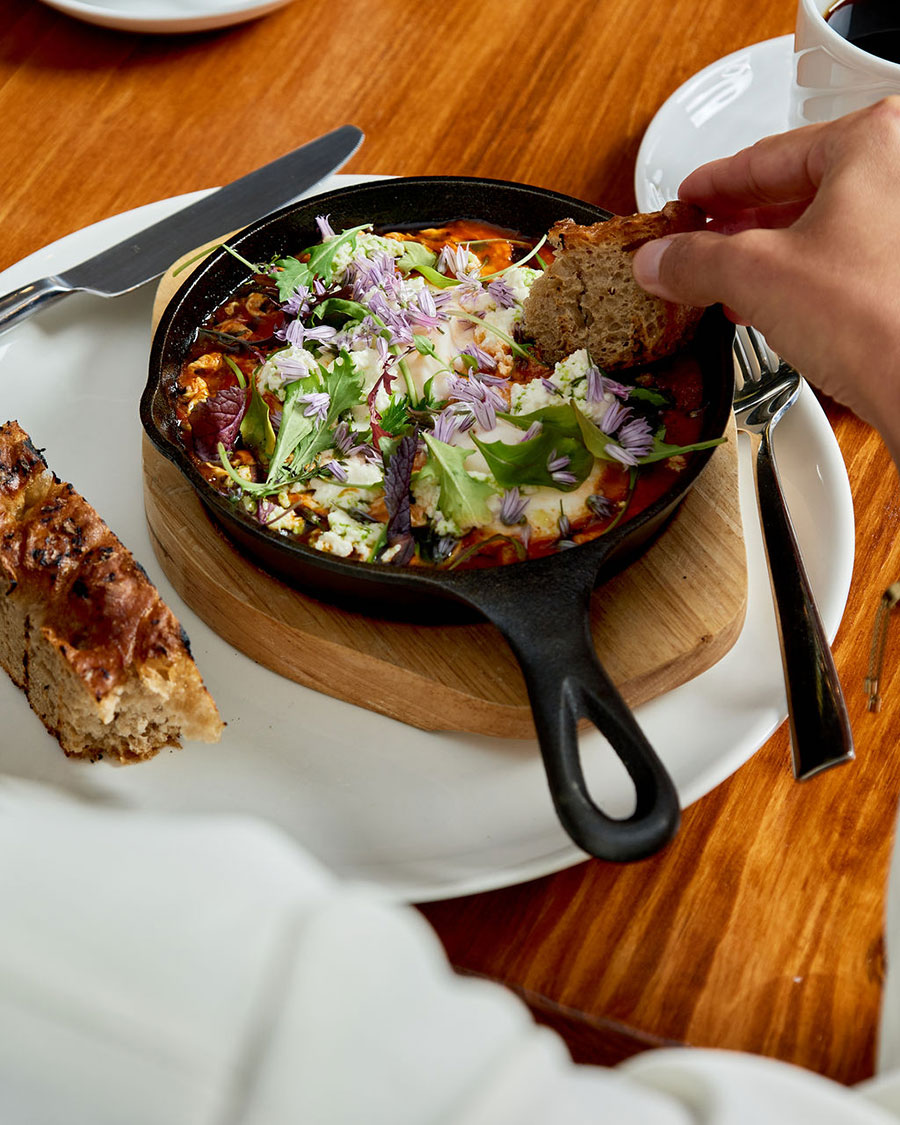A Guide to Sustainable Diets From Ontario Eco-Chef Chris Locke, Plus His Recipe for Shakshouka

This eco-friendly Shakshouka is a wonderfully comforting start to the day. Photo: Courtesy of Rawley Resorts
We’ve heard of plant-based diets and weight loss diets, but what is a sustainable diet? More importantly, why is it of interest and how easy (or difficult) is it to follow?
Sustainability, in a nutshell, is about protecting the planet. It might be a buzzword in travel but sustainability is also gaining traction in health and wellness. A concept that’s becoming generally accepted, it has even been shown, in a 2022 paper published by a group from the University of Arkansas in Frontiers of Nutrition, that both the environment and the population’s health can benefit from adopting a plant-based diet.
The Food and Agriculture Organization of the United Nations has defined sustainable diets as “those diets with low environmental impacts, which contribute to food and nutrition security and to healthy life for present and future generations. Sustainable diets are protective and respectful of biodiversity and ecosystems, culturally acceptable, accessible, economically fair and affordable; nutritionally adequate, safe and healthy; while optimizing natural and human resources.”
“Our planet is under enormous pressure from human existence and we are now in a period of global boiling,” says chef Chris Locke, previously of Toronto’s first farm-to-table restaurant, Marben. “As our planet continues to warm and extreme climate events become evermore frequent, our everyday eating choices have never held more importance.”

British-born Locke spotlights the best of Ontario’s ingredients in thoughtfully prepared seasonal fare. He’s not afraid to use fermentation and preservation techniques to help extend the shelf life of the pristine products. As the consulting eco-chef of Port Severn’s Rawley Resort, Locke has stepped in to update the property’s main restaurant, Lighthouse45, with an eco-friendly menu.
The well-received overhaul addresses not only contemporary needs but has also injected the menu with fresh and vibrant flavours. The kitchen uses ethically sourced ingredients from local farms, butchers, wineries and breweries, which are showcased in main courses like the juicy pan-seared heritage pork chop that’s dressed with prosciutto jus and capped with an umami-rich topping of anchovies and dandelion capers. It also follows closed-loop zero waste processes wherever possible, transforming byproducts like whey into the cheekily named potato sour cream and onion dish that features whey-poached butterball potatoes in an ethereal bath of cultured cream laced with wild onion oil and fermented red chillies. Spent coffee grounds are given new life as a rich syrup that finishes a silky white pine crème caramel.

At breakfast, there are thick stacks of fluffy whole wheat pancakes that are christened with whipped custard and caramelized apples, and breakfast sandwiches stuffed with free-run pork and bacon or grilled spiced eggplant. But, it’s the flavour-packed shakshouka that coddles free-run eggs in a beautiful chickpea- and homemade ricotta-studded zero waste harissa and tomato sauce that will make you do a double blink, especially knowing it’s a sustainable dish.
“Working towards a sustainable diet does not have to mean sacrificing flavour or spending more,” says Locke. “There are some simple things we can all do to help ease the burden on the world, benefit our bodies and reduce our grocery bills.”
Here are some tips from Locke on how to eat and cook more sustainably.
Tip 1: Shop in Small Quantities
Leave the “just in case” perishable purchases at the grocery store or market. Don’t be fooled by buying in bulk. Sometimes life gets away from us and purchases made with the best intentions can be forgotten and left to expire in the fridge. Where possible, make smaller purchases of fresh, perishable items and don’t be afraid to use the freezer to make things last!
Tip 2: Save Your Scraps
Vegetable scraps, animal bones and cheese rinds are a great way to add extra flavour into your cooking. You can use these to make simple stocks that can then be added to stews, soups, risotto and more, to add some zero-waste goodness. To make things more efficient, freeze those scraps in containers until you have a good amount, simmer in water and strain!
Tip 3: Eat More Beans
Sixty billion livestock animals are raised every year on the planet, a practice that is responsible for somewhere between 18 per cent and a whopping 51 per cent of global greenhouse gas emissions. Cutting down on your animal protein consumption can have a large, positive impact. However, a reduction in eating meat can diminish a valuable source of protein. The solution: Beans! Beans and pulses provide a delicious solution that is great for farmers, soil and our bodies.
Tip 4: Avoid Excess Packaging
We are all now aware of microplastics and their increasing presence in our oceans and food. With only nine per cent of plastics being recycled and an estimated 30 million tonnes of plastic waste ending up in our seas and oceans, reducing our reliance on them is paramount.
If there is an option to buy items loose rather than in their own packaging, or shopping at a zero-packaging bulk store, you are making a positive impact.
Tip 5: Support Your Local Farmers Market
Eating produce grown locally does not necessarily reduce the carbon footprint of the food we eat. Transport only accounts for around seven per cent of the total greenhouse gas emissions. But, it does connect us with the land, environment and food producers. It’s far easier to ask the farmer how something is grown at your local market than from a farm in Chile.
These conversations and interactions connect us to our food producers but also supports agricultural practices using organic and regenerative growing methods, all of which are critically important to building back resilience, biodiversity and soil health.
Tip 6: Take Home Leftovers
Fifty-eight per cent of all food in Canada is lost or wasted. Of that amount, 32 per cent (about 11.2 million tonnes annually) is edible food that could be redirected to support Canadians. Reducing food waste is another way to curb our consumption and lessen the pressure on the planet to produce food.
The next time you find yourself at a restaurant and have leftovers, consider having it packed up to enjoy the next day. Just think about how satisfying those first few bites were and savour the opportunity to relive those moments. It might also save you the need to buy lunch!
Rawley Resort’s Shakshouka

This dish is a wonderfully comforting start to the day. Packed with flavour and protein, it will keep your belly and soul satisfied until late in the afternoon. It’s a less complex version of the dish to make it easier to make at home, but will still taste as delicious. Bonus: The sauce can be easily frozen in portions.
It also has the same carbon footprint as a car travelling 5km; in contrast, the carbon footprint of a bacon, egg and cheese sandwich is the equivalent to travelling 18km in a car.
Serves 4
Ingredients:
Sauce:
¼ cup (60 g) harissa paste
4 cups (1 kg) tomato passata (uncooked tomato purée that has been strained of seeds and skins)
2 cups (110 g) red onion, finely diced
2 tablespoons (30 ml) oil (canola, olive, sunflower)
Salt, to taste
Dish:
1 cup (152 g) canned chickpeas
8 eggs, preferably free run or pasture-raised
80 g ricotta (or similar soft cheese)
1 bunch chives, finely chopped
4 slices focaccia or bread of choice
Directions:
Sauce:
- In a saucepan, sweat the red onion in the oil over a medium heat until translucent and sweet.
- Add in the harissa paste and continue to sauté until fragrant.
- Add in the tomato passata and bring to a simmer.
- Continue to simmer for around 20 minutes. Add salt to taste.
- Remove from heat and allow to cool. This can be stored and frozen if needed at a later date.
Dish:
- In a large frying pan or skillet, add the chickpeas and sauce. Bring to a simmer.
- Crack the eggs directly into the sauce and cover with a lid to aid the cooking process. Cook for around 10 minutes. The eggs will be cooked but still have soft yolks.
- Remove the pan from the heat. Remove the lid and sprinkle the dish with the ricotta and chives.
- Season the tops of the eggs with a little salt and serve in the pan with focaccia or any other preferred ‘edible scoop.’
Recipe courtesy of Chris Locke on behalf of Rawley Resort and Lighthouse45.
RELATED:
7 Ways to Reduce Food Waste (And Keep More Cash in Your Wallet)
3 Reasons to Add Plant-Based Proteins Into Your Diet
How Urban Gardens Can Boost Biodiversity and Make Cities More Sustainable